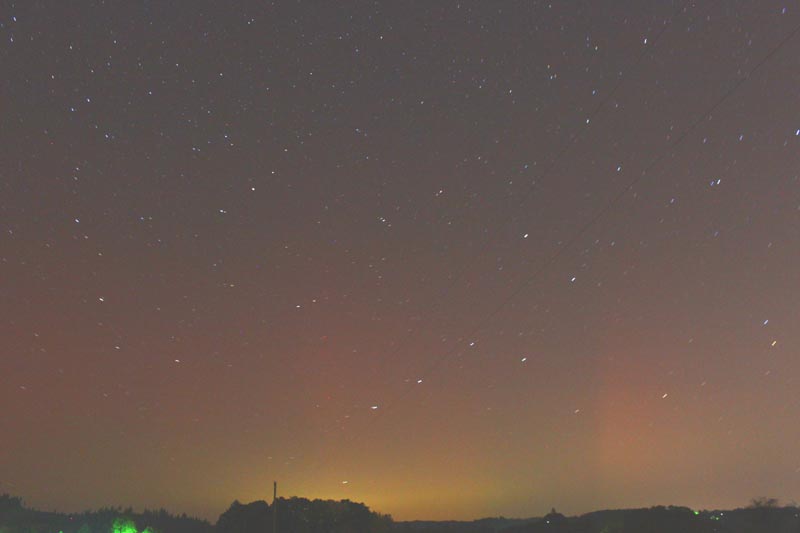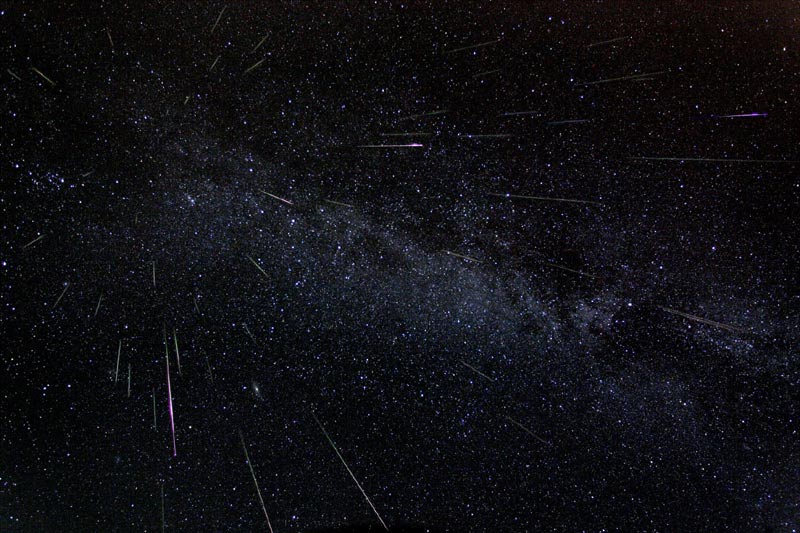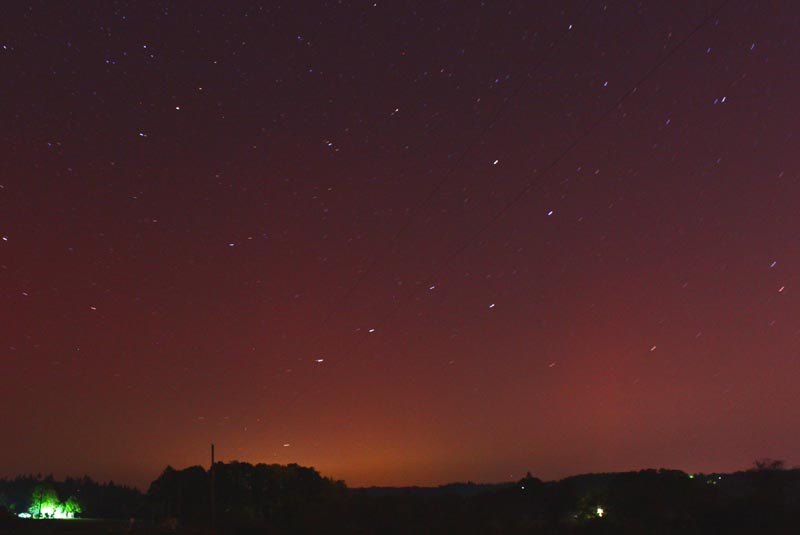Possible Aurora - Oct Meteor Showers, Blue Moon for Oregon, Washington Coast
Published 09/28/20 at 7:41 PM PDT
By Oregon Coast Beach Connection staff

Includes exclusive listings; some specials in winter
In Cannon Beach:
Includes rentals not listed anywhere else
In Manzanita, Wheeler, Rockaway Beach:
Some specials for winter
In Pacific City, Oceanside:
Some specials for winter
In Lincoln City:
Some specials for winter
In Depoe Bay, Gleneden Beach:
Some specials for winter
In Newport:
Look for some specials
In Waldport
Some specials for winter
In Yachats, Florence
Some specials for winter
(Cannon Beach, Oregon) – A blue moon, a meteor shower and the possibility of northern lights. This is what’s happening or possible along the Oregon and Washington coast in October – maybe even tonight. (Above: Aurora Borealis in the Oregon Coast Range in 2011).
The biggest and most immediate interstellar news that involves the Oregon and Washington coast is the possibility of seeing the Aurora Borealis tonight and / or Tuesday night in the region. For the Portland area and southern Washington, chances are “slim,” according to OMSI astronomy expert Jim Todd.
“According to Estimated Planetary K Index forecast is below 6,” Todd told Oregon Coast Beach Connection. “Really depends how strong the remaining solar storm surge will be in the northern hemisphere on September 29th. Take a peek later tonight, look north just above the horizon. The moon is in waxing gibbous phase.”
According to SolarHam.com, northern Canada is in for an eyeful, but Washington state and Oregon are in a zone that is iffy for the northern lights.
According to the National Weather Service:
“NOAA forecasters say there is a chance of more G1- and G2-class storms on Sept. 29th as our planet continues its transit through a high-speed stream of solar wind. The gaseous material is flowing 600+ km/s from a large hole in the sun's atmosphere.”
The southern Oregon coast won't get to see the Aurora, but the entire northwest shoreline will get to witness other phenomena.
Starting very soon, the Orionid meteor shower will make its presence known throughout October, peaking on October 21. The Orionids actually begin October 2 and run through November 7, caused by the Earth passing through the stream of debris left by Comet Halley.
Scientists say look in the last hours before dawn, when the most meteors can be seen. The crescent moon will be setting by mid evening, providing largely darker skies.
According to Space.com, the peak around the 21st may mean as many as 10 to 20 streaks an hour, but nothing is guaranteed there. It could make for more – it could be far less.
The Orionids are extremely fast, about 66 kilometers – 41 miles – per second as they hit the atmosphere.
Where to see them on the Oregon or Washington coast? Higher vantage points help a little, such as Cape Arago near Coos Bay, the gravel pullout just north of Cape Perpetua, Anderson’s Viewpoint near Oceanside, or Cape Foulweather or the Neahkahnie Lookouts near Manzanita. These sights are, of course, weather dependent.
Also on the galactic menu for October are two full moons, the last of which is called a blue moon.
“Next month (October already!), we'll be gifted two full moons,” Todd said.
Oregon Coast Hotels for this event - Where to eat - Map - Virtual Tour
The first full moon, the Harvest Moon, will be on Thursday, October 1st at 2:05 p.m. It refers to the full moon that occurs closest to the first day of autumn; this year, it was on September 22. Depending on the year, the Harvest Moon can fall before or after the autumnal equinox which arrives annually on or near September 22nd.
The next full moon will occur on Halloween, October 31, 2020 at 7:49 a.m. and will be named the Hunter's Moon. Halloween is a “cross-quarter” day, a way marker for halfway between the equinox and solstice. Typically, the second of two full moons to occur in a single calendar month is nicknamed a Blue Moon. The last Blue Moon was on March 31, 2018. More Aurora Borealis and stellar sights below.
See Oregon Coast Weather - Washington Coast Weather
Cannon Beach Lodging
Nehalem Bay Lodgings
Manzanita Hotels, Lodging
Three Capes Lodging
Pacific City Hotels, Lodging
Lincoln City Lodging
Depoe Bay Lodging
Newport Lodging
Waldport Lodging
Yachats Lodging
Oregon Coast Vacation Rentals
Oregon Coast Lodging Specials

Meteor photo courtesy NASA
More About Oregon Coast hotels, lodging.....
More About Oregon Coast Restaurants, Dining.....
LATEST Related Oregon Coast Articles
Through 2 a.m. likely best, but some lights possible through dawn June 1 - 2. Space weather, astronomy
Rare Sperm Whale Stranding on N. Oregon Coast, Was Hit by Boat
Showing up near Gearhart, it will decompose naturally. Marine sciences
Coast Guard Barque 'America's Tall Ship' Coming to Portland Rose Fest, N. Ore...
Portland events: June 5 - 8; Astoria events June 13 - 15. Weather
Bright and Active Arietids Meteors May Hit Pre-Dawn Hours of Oregon, Washingt...
Look to east hour before sunrise and you may catch a show. Sciences, astronomy, weather
Why Now Could Be a Great Week for Spotting Killer Whales on Oregon Coast - Video
A good dozen documentations around Depoe Bay, Newport, Coos Bay, Bandon, Tillamook. Marine sciences
Summer Road Work, Traffic Issues Along Oregon Coast Include Astoria, Garibald...
Some daylight closures include bridges, OR 22, OR 18, OR 26, more. Travel tips. Seaside, Cannon Beach, Lincoln City. Travel tips
Pacific City Oregon Weather, 7-Day Forecasts, Live Conditions, Radar, Webcams...
Updated Constantly: Pacific City, Tierra Del Mar, Oregon Weather, Cams, Buoy Observations, Tides, Warnings - Alerts
Oregon Coast Has World's Oldest Harbor Seal, Celebrating 50 Years Soon
June 3 at Oregon Coast Aquarium in Newport. Newport events
Back to Oregon Coast
Contact Advertise on BeachConnection.net
All Content, unless otherwise attributed, copyright BeachConnection.net Unauthorized use or publication is not permitted















































